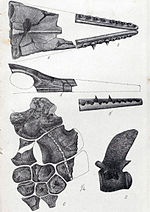Dinosaurs
- Richard Owen publishes a monograph on Wealden and Purbeck reptiles, classifying Scelidosaurus , Iguanodon and Echinodon in the new dinosaur clade Prionodontia. [2]
| |||
|---|---|---|---|
| +... | |||
Paleontology or palaeontology is the study of prehistoric life forms on Earth through the examination of plant and animal fossils . [1] This includes the study of body fossils, tracks ( ichnites ), burrows , cast-off parts, fossilised feces ( coprolites ), palynomorphs and chemical residues . Because humans have encountered fossils for millennia, paleontology has a long history both before and after becoming formalized as a science . This article records significant discoveries and events related to paleontology that occurred or were published in the year 1874.
| Name | Status | Authors | Age | Unit | Location | Notes | Images |
|---|---|---|---|---|---|---|---|
Valid | Seeley | Middle Jurassic (Callovian) | An ophthalmosaurid ichthyosaur. | ||||
| Name | Status | Authors | Age | Unit | Location | Notes | Images |
|---|---|---|---|---|---|---|---|
Valid | Seeley | Late Jurassic (Kimmeridgian) | A cryptoclidid, new genus for "Plesiosaurus" megadeirus Seeley, 1869 | ||||
Valid | Seeley | Early Jurassic (Hettangian-Sinemurian) | A member of Microcleididae; new genus for "Plesiosaurus" rugosus Owen, 1840. | ||||
Hector | Late Cretaceous (late Campanian-Maastrichtian) | An elasmosaurid. | |||||
Valid | Seeley | Middle Jurassic (Callovian) | A cryptoclidid. | ||||
Valid | Seeley | Early Jurassic (Toarcian) | A rhomaleosaurid; new genus for "Plesiosaurus" cramptoni Carte and Bailey, 1863 | ||||
| Name | Status | Authors | Age | Unit | Location | Notes | Images |
|---|---|---|---|---|---|---|---|
Valid | Owen | Early Cretaceous (Valanginian) | A member of Ornithocheiridae. | ||||
Jr. synonym | Owen | Jr. synonym of Ornithocheirus . | |||||
| Name | Status | Authors | Age | Unit | Location | Notes | Images |
|---|---|---|---|---|---|---|---|
| Taniwhasaurus | Valid | Hector | Late Campanian | Conway Formation |  |